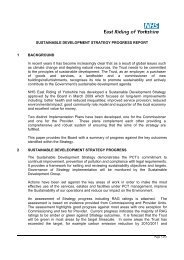Guidelines for the Management of Haematological Malignancies
Guidelines for the Management of Haematological Malignancies
Guidelines for the Management of Haematological Malignancies
You also want an ePaper? Increase the reach of your titles
YUMPU automatically turns print PDFs into web optimized ePapers that Google loves.
14 CUTANEOUS LYMPHOMA<br />
The WHO classification <strong>of</strong> cutaneous T cell lymphomas<br />
There are three main groups in decreasing order <strong>of</strong> prevalence:-<br />
1. Mycosis fungoides and Sezary syndrome<br />
Rare variants: Pagetoid reticulosis ( a verrucous acral variant)<br />
MF-associated follicular mucinosis<br />
Granulomatous slack skin disease<br />
2. Primary cutaneous CD-30 positive T-cell lympho-proliferative disorders<br />
Variants: Lymphomatoid papulosis (types A and B)<br />
Primary cutaneous Anaplastic Large Cell Lymphoma<br />
Borderline types<br />
3. O<strong>the</strong>r rare T cell lymphomas presenting in <strong>the</strong> skin<br />
a. Subcutaneous panniculitis-like T-cell lymphoma<br />
b. Peripheral T-cell lymphoma unspecified - an aggressive lymphoma which always<br />
requires systemic <strong>the</strong>rapy<br />
Peripheral T-cell Lymphoma involving <strong>the</strong> skin at presentation<br />
• The skin and sub-cutaneous tissue is commonly involved by systemic T-cell lymphomas.<br />
• All <strong>of</strong> <strong>the</strong>se lymphomas have an aggressive course and poor prognosis, even if <strong>the</strong>y appear<br />
localised to <strong>the</strong> skin at presentation.<br />
• All <strong>of</strong> <strong>the</strong>se tumours are treated using combination chemo<strong>the</strong>rapy<br />
• These patients must be referred urgently to a haemato-oncology MDT (Leeds, Hull, Mid-<br />
Yorks, Brad<strong>for</strong>d and Airedale, York & Harrogate).<br />
• Peripheral T cell lymphoma should not be confused with CD30+ T-cell lymphoproliferative<br />
disorders (see below).<br />
Cutaneous CD30 positive lymphoproliferative disorders<br />
Diagnostic Criteria<br />
Typical Type A lymphomatoid papulosis<br />
1. A wedge shaped lesion with a peripheral zone which contains a mixed inflammatory infiltrate<br />
and a central zone containing atypical large lymphoid cells. In <strong>the</strong> central zone <strong>the</strong>re may be<br />
necrosis or ulceration.<br />
2. The characteristic cells are large with highly anaplastic or multilobated nuclei. They have a Tcell<br />
phenotype with strong CD30 expression. ALK1 is negative.<br />
3. The definitive diagnosis requires a history <strong>of</strong> self-healing lesions.<br />
Variants<br />
1. CD30 + primary cutaneous anaplastic large cell lymphoma. The cells are <strong>the</strong> same as in<br />
lymphomatoid papulosis but in <strong>the</strong> context <strong>of</strong> a progressive non-healing lesion. The presence<br />
<strong>of</strong> ALK1 almost certainly implies that <strong>the</strong> tumour is a systemic anaplastic lymphoma, which<br />
may be o<strong>the</strong>rwise identical, and <strong>the</strong>se markers must be shown to be negative <strong>for</strong> a diagnosis<br />
<strong>of</strong> primary cutaneous T-cell lymphoma to be made. A final diagnosis can only be made after<br />
staging investigations.<br />
Patients with anaplastic lymphoma must be referred to a Haemato-oncology Unit URGENTLY<br />
2. Type B lymphomatoid papulosis. This consists <strong>of</strong> small cells, similar to mycosis fungoides and<br />
CD30 negative. Diagnosis only possible if typical history available.<br />
<strong>Guidelines</strong> <strong>for</strong> <strong>the</strong> <strong>Management</strong> <strong>of</strong> <strong>Haematological</strong> <strong>Malignancies</strong><br />
14. CUTANEOUS LYMPHOMA<br />
30

















